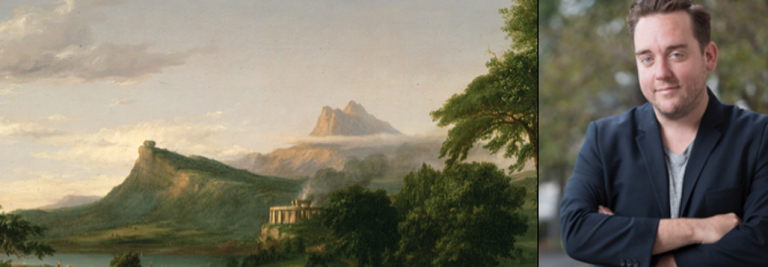Welcome to the new blog on the intersection between faith and culture entitled Arcadia! I’m so happy you’re here and hopefully will stick around bi-weekly as we delve into some of the ways that our seemingly ordinary lives are enriched by our greater Catholic consciousness and imagination often found in the culture around us as in films, visual arts and literature. Our new blog’s title is an enigmatic one and reaches all the way back to antiquity. The term, Arcadia, refers to a vision of pastoralism and harmony with nature. It is named after a mountainous region in Greece and has become a euphemism for an idyllic vision of unspoiled wilderness, simplicity, innocence and beauty. For the ancients, artistic expression was to reach this Arcadian perfection or, as Shakespeare wrote, “to hold, as ’twere, the mirror up to nature” (Hamlet, 3.2).
Saint John Paul II spoke of this Arcadian ideal when discussing the vocation of artists. He writes, “The artist has a special relationship to beauty. In a very true sense it can be said that beauty is the vocation bestowed on him by the Creator in the gift of ‘artistic talent’” (Letter to Artists, 1999).
Asleep yet? I know it is a little tough, but the implications to this are huge! Unlike some of our brothers and sisters in other faith expressions, Catholicism places a huge emphasis on artistic expression! Saint John Paul II is saying that the artist possesses a God-like gift! “In the beginning God created…” (Genesis 1:1) are the first words in the entire Bible; our first recognition of God is as the Creator—the artist. So if the gift of the artist is so esteemed, then the gift of their work is a part of the Catholic conversation! It is how we try to explain ourselves to God and each other. Unlike some other faithful expressions, we don’t turn away from the wider culture of controversial artistic expressions or worn read classics. Rather, we flock to them! It is part of our Catholic identity to look at the painting or view the dance or listen to the music and ask ourselves, What does this mean? How does this movie, novel, painting help me understand who am I, who am I in the world and where am I on this journey back to God?
Okay, you may say, but what about the junk? Surely, violence in films or sexuality on television can’t help our spiritual journey and, in some cases, that’s true, but maybe a mysterious Latin phrase can help “Et in Arcadia Ego.” Roughly translated “Et in Arcadia Ego” means “Even in Arcadia, there am I” referring to the “I” of death. Even in this beauty, death and sin are always present. It serves us a chilling reminder and a deep challenge. We can’t just ignore the tough stuff. It was a controversy for the Church for years that what we now see as beautiful was at times thought of as vile.
Saint John Newman once remarked in his defense that a Catholic education include secular books he wrote. “It is a contradiction in terms to attempt a sinless Literature of sinful man. (Idea of a University, Discourse 9). So, in this blog we’ll be talking about the tough stuff, the sticky stuff, the films and novels that may bring up contradictions and entanglements, the contemporary art movements and visual art pieces that make us ask the tough questions, the ones that punch us in the gut—it is a perilous journey for sure, but one we must embark on as we search for our own Arcadia, as we search our lives for a deeper meaning to practice what Saint Paul so beautifully preached, “Finally, whatever is true, whatever is honorable, whatever is just, whatever is pure, whatever is lovely, whatever is gracious, if there is any excellence and if there is anything worthy of praise, think about these things (Philippians 4:8). Think about these things. That’s a powerful challenge and one that can lead to praying about things and giving others things. And, to think all we had to do was go to the movies! Hope you stick around!
I’ll be seeing you,
Elliot
Cover Art: The Arcadian or Pastoral State, second painting in The Course of Empire, painting series by Thomas Cole 1833-36.



